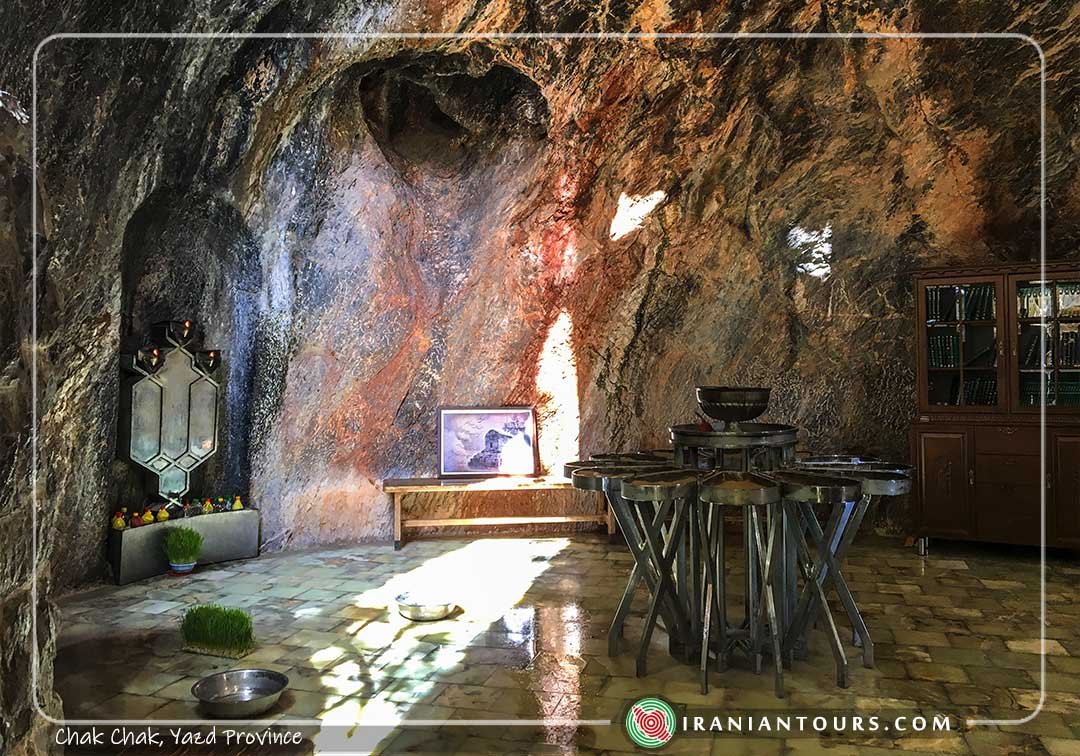Chak Chak
The village of Chak Chak, also known as Pir’e Sabz, consists of a Zoroastrian Fire Temple perched beneath a towering cliff face in the desert of central Iran. It is located amongst the mountains of Ardakan and Anjireh on the way to Tabas, about 46 kilometers from Yazd.
It is the most sacred of the Zoroastrians mountain shrines. Located near the city of Ardakan in Yazd province, Chak Chak serves as a pilgrimage point for pious Zoroastrians. Each year in June thousands of Zoroastrians from Iran, India, and other countries flock to the fire temple of Pir’e Sabz. Tradition has it that pilgrims are to stop the moment they see the sight of the temple and continue their journey on foot the rest of the way. Once there they light candles in line with the Zoroastrian belief that fire symbolizes God’s light and under the credo of “good thoughts, good speech, good deeds”. Large groups of pilgrims stay in residences built by the local Zoroastrians of the village of Sharif Abad.
Chak Chak temple is revered for its spiritual values in the hearts of the followers of the ancient Iranian religion. The fact that caves and cracks within the rocky slopes of the mountains had long been a refuge for spiritual people to sit in, in absolute isolation and meditate should come as no surprise.
The actual temple of Chak Chak is a man-made grotto sheltered by two large bronze doors. The entrance of the temple is reached through a two-planked doorway over which stands an embossed image of two Achamenian soldiers. The shrine enclosure is floored with marble and its walls are darkened by fires kept eternally burning in the sanctuary. In the cliffs below the shrine are several roofed pavilions constructed to accommodate pilgrims. The Temple cut into the cliff-side at the top has a wonderful brass door that is embossed with the likeness of Zoroaster. The temple has an altar in which there are three oil-burning lights with a container of oil right beside them. In front of the altar, there is a set of trays combined in such a way as to look like a lotus flower from above and serves as a place to receive donations from pilgrims. There are also some window-like open spaces or holes within the cave over which huge branches of the nearby tree extends inside the temple and a small waterfall that keeps the stage of the alter wet (upon which no one is allowed to step).
Meaning “drip-drip” in Persian, Chak Chak is where Nikbanou, second daughter of the Sassanid Emperor Yazdegerd III of Persia, was cornered by the invading Arab army in 640 CE. Fearing capture Nikbanou prayed to Ahura Mazda to protect her from her enemies. Notable features of Chak Chak include the ever dripping spring located at the mountain. Legend has it that these drops are tears of grief that the mountain sheds in remembrance of Nikbanou. Growing beside the holy spring is an immense and ancient tree said to be Nikbanou’s cane. Legend also has it that a petrified colorful cloth from Nikbanou was also visible in the rocks although pilgrims have since taken this (if it ever was there).






